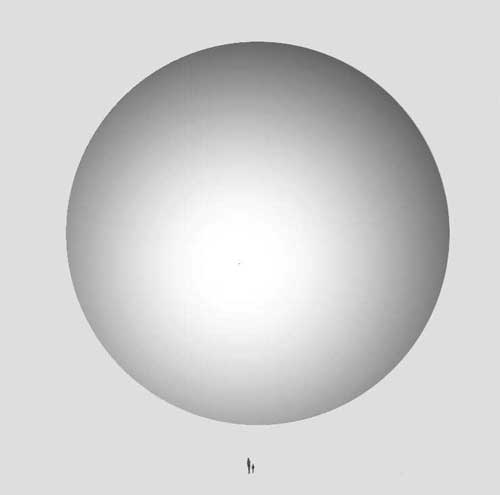
Thao and Michel in front of interstellar spacecraft, that levitates when stationary. The diameter of the spacecraft is 80 meters. Propulsion system is explained here.
On the 35th anniversary of Michel Desmarquet journey to Thiaoouba, the spacecraft visited Dr Chalko at Mt Best. Its size in the sky was comparable to the full moon, as can be seen in the attached photos. When Dr Chalko took these two photos - the spacecraft was about ~7 km above the remote uninhabited forest. The elliptical halo around the spacecraft is the result of operation of a cyclotron that is involved in propulsion. More details
Doko is an electromagnetic building, based on the principle of an atom. A force field around nucleus (the size of which is comparable to an egg) creates an "empty space" 30-80 meters in diameter suitable for habitation and protected from external elements such as wind and rain.
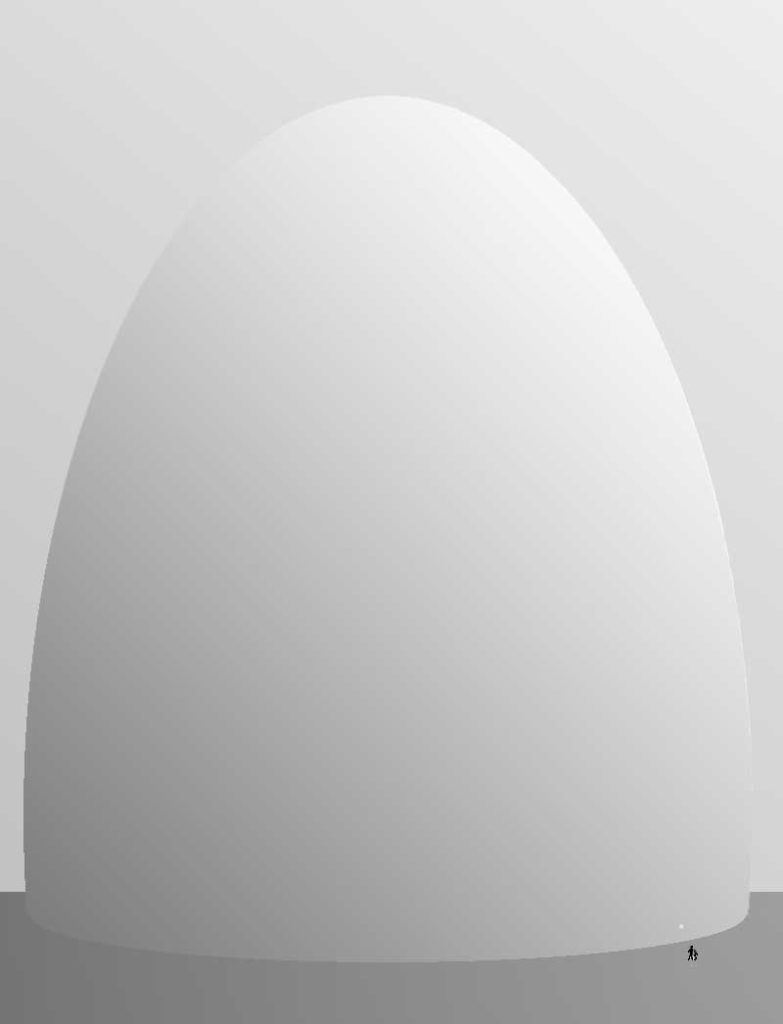
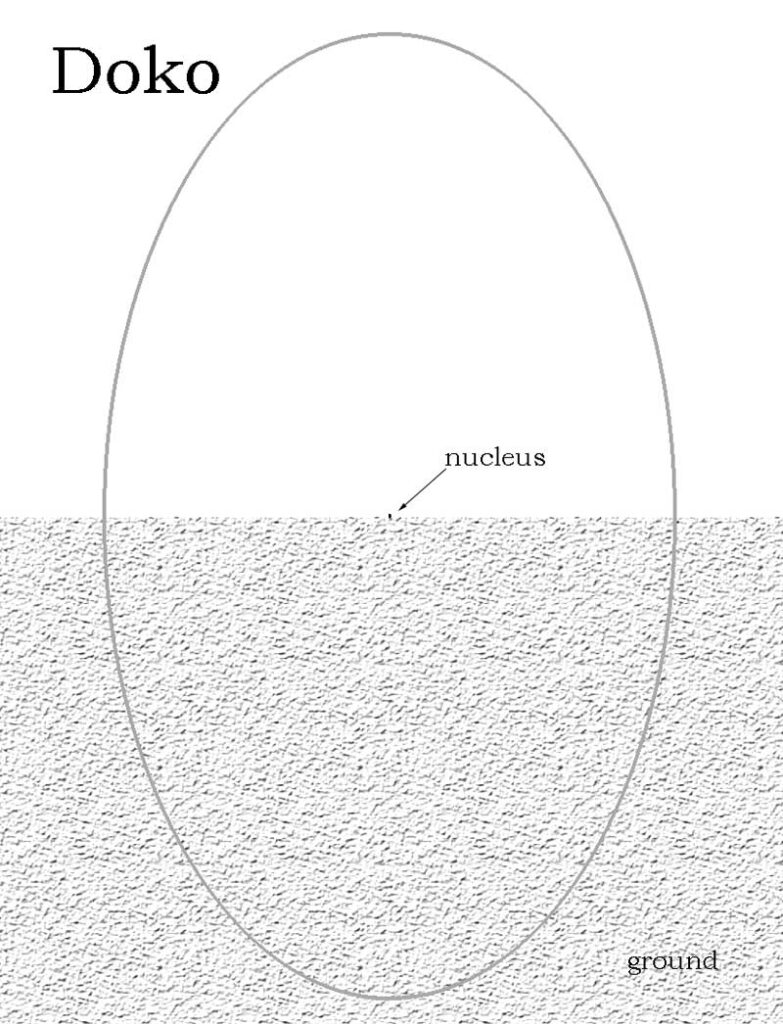
The lower half of doko is underground and can also rest on the bottom of a lake. It is impossible to "lift" or "move" the nucleus of a doko standing next to it, just as it is impossible for you to lift a chair you are siting on. The surface of the doko is semi-transparent. It is impossible to see the inside from the outside, but when we are inside - the walls of doko become "invisible" creating a sensation of being outdoors.
The biblical Enoch (great-grandfather of Noah, who built the famous ark) visited Thiaoouba when he was 365 years old. It occurred approximately 980 years after Hebrews misfortune landing on Earth, around 12,000 years ago, and about 670 years before the biblical flood that destroyed most of humanity on Earth, because people had degraded themselves to moral and spiritual bottom. The "Book of Enoch" refers to dokos as "crystal palaces". Michel Desmarquet personally confirmed that Enoch indeed visited Thiaoouba. Illustration and explanation by Dr Tom Chalko.
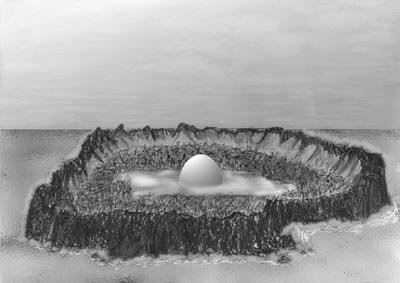
Golden doko on an island on Thiaoouba. When Michel Desmarquet saw this illustration he said that it looks like a photograph of what he saw.
Inside the Golden Doko there are 147 bodies created for messengers from Thiaoouba, who tried to assist people on 147 different planets in their spiritual evolution. One of these levitating bodies is the body of Jesus, who ~2000 years ago came back to life on the 3rd day after his crucifixion, thereby demonstrating to everyone the immortality of consciousness.
In 1987 Michel Desmarquet personally saw the body of Jesus very closely but he was not allowed to touch it. The illustration below was created in some 30 iterations and modifications in cooperation with Michel Desmarquet - until Michel approved it as reflecting the reality of what he saw.

This body has no belly button, because it was not born to a woman. This adult body was created by Thaori specifically for its mission on Earth - to demonstrate immortality of consciousness and inspire everyone to think about it for millenia. Physically, this body is a "twin-copy" of a man born to virgin Mary in Bethlehem from an embryo delivered by 3 "angels" from Thiaoouba.
Please note injuries sustained by this body: a large gash below right ribs and nail punctures on feet and wrists. Punctures on WRISTS are very important and indicate that Michel indeed saw a body that had been crucified.
For centuries, all religious images and sculptures of crucified Jesus depict his body hung on nails through palms of his hands. However, it is physiologically impossible to hang a living 180cm tall man like this - nails would tear the soft tissue, slip between fingers and the body would quickly fall from the cross. Romans crucified people by nails through their WRISTS, so their victims could remain hung on the cross for many days.
A question arises here: WHY is the body of Jesus, along with the other 146 bodies, preserved for thousands of years rather than being discarded? Surely not just to be shown to Michel Desmarquet... The most logical explanation seems to be that these bodies wait to be used again.
If Jesus visited Earth for the second time - how many people would recognize him? Would he be killed again by authorities?
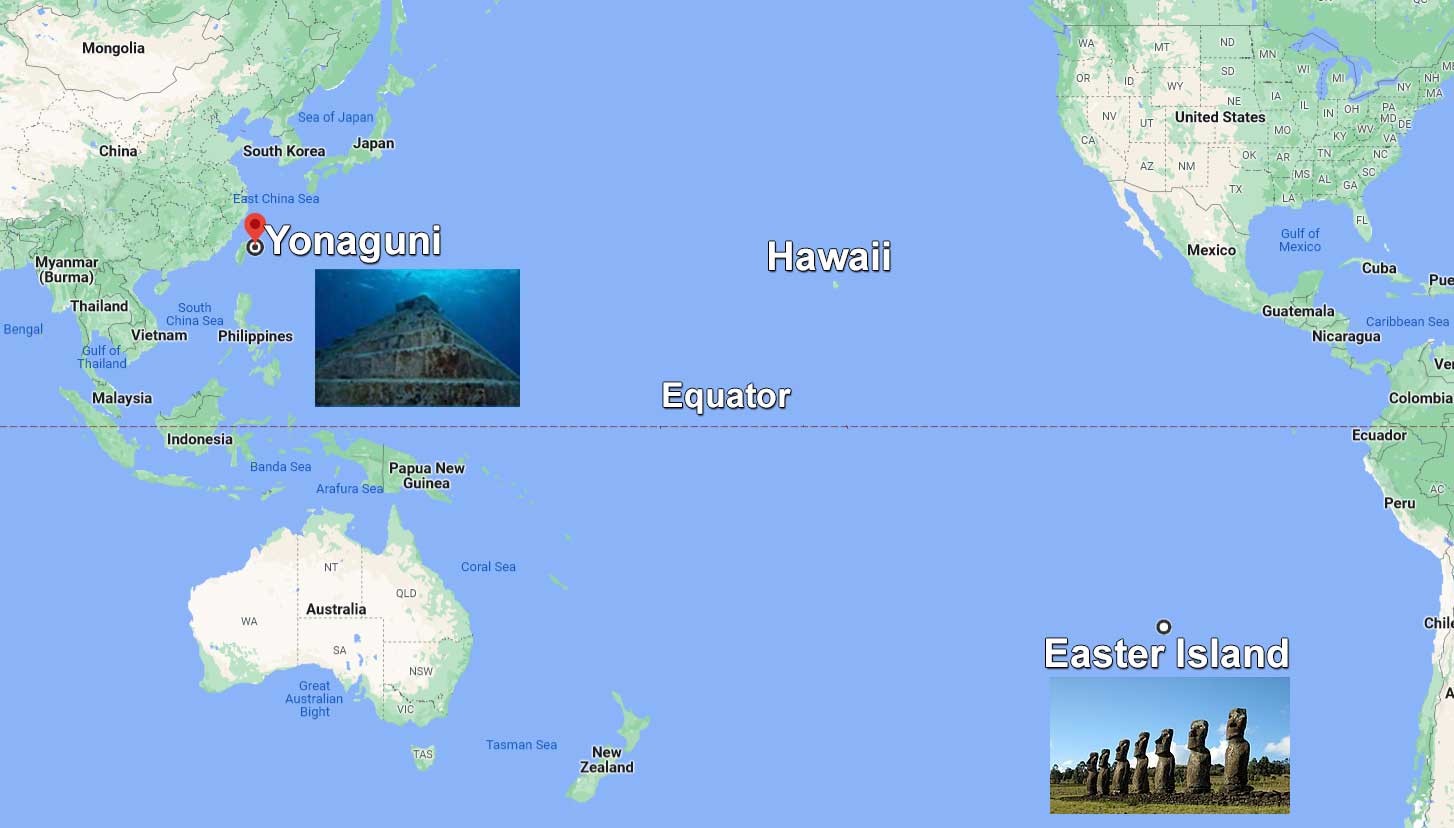
Continent Mu, also known as Lamar or Lemuria existed until ~14,500 years ago and extended from Yonaguni (Japan) to Easter Island (Chile). Catastrophic sinking of the continent Mu, described in the Thiaoouba Prophecy book, have caused the Andes mountain ranges to rise in South America. The underwater "pyramids" of Yonaguni and the gigantic statues of Easter Island are material remains of the continent of Mu. Both Yonaguni and Easter Island were quarries (sources of stone). The quarry of Easter Island was much larger than the island itself, but archaeologists had not yet imagined exploring the underwater areas of Easter Island…

The most developed civilization in the history of Earth existed on the continent of Mu between approximately 250,000 and 14,500 years ago. The illustration shows the road to the palace of the king of Mu. The statues are 50 meters tall, and the pyramid is 440.01 meters high.
For comparison, the largest pyramid in Egypt (the so-called Great Pyramid or Pyramid of Cheops) is exactly one-third the size - its original height was 146.67 meters, including the precious metal cap.
The road leading to the palace of the King of Mu, like all roads on this continent, was constructed from flat stone slabs cut by electro-ultrasound with an accuracy of 0.2 mm, assembled so precisely that no joints were visible.
It was easier for the inhabitants of Mu to cut huge slabs (up to several dozen tons) from the hardest solid rock they could find and transport them from the quarry several thousand kilometers away by levitation than to make screeds, castings or asphalt... Roads made of solid stone remained functional for hundreds of thousands of years. Do you know anyone who could imagine a civilization on Earth functioning peacefully for hundreds of thousands of years? Do you know anyone who could imagine a civilization on Earth that does not use any money? Have a look at philosophy of Mu.
The methods of cutting stone and neutralizing the gravitational force for transportation and during construction were also used in the process of constructing pyramids.
Huge spherical lamps, visible in the illustration above, converted nuclear energy directly into visible light and shone continuously for thousands of years.
Michel Desmarquet, author of Thiaoouba Prophecy book, said that this illustration looks like a photograph of what he was shown.
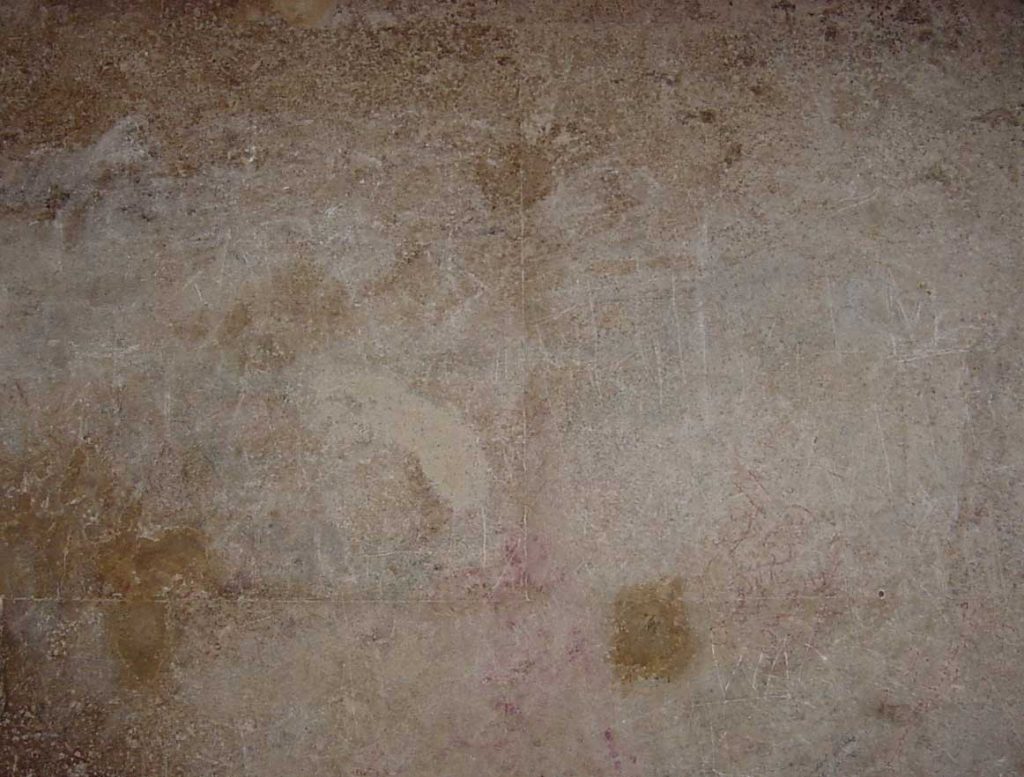
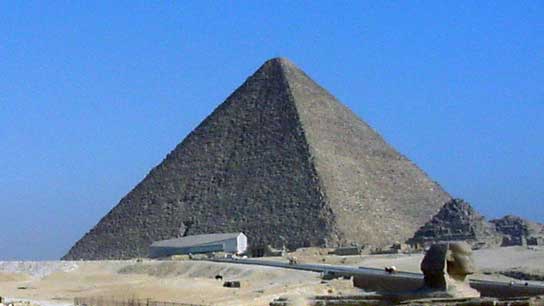
The first photo, taken inside the Great Pyramid in Egypt (also called the Pyramid of Cheops), illustrates the precision of the electro-ultrasound stone-cutting technology available during its construction, approximately 17,000 years ago, by Toth, a founder of Egypt. Try to notice the joints between the precisely cut stone slabs, each weighing approximately 10-50 tonnes.
The joints between all the stone slabs in the pyramid are so precise that it is actually difficult to spot them. All these joints - many kilometers in length - are super-straight and precisely parallel, as far as the eye can see in the pyramid corridors, as straight as laser beams.
What is truly intriguing is that these stone slabs are cut from a very soft type of limestone - so soft and brittle, in fact, that it can be scratched by a fingernail, as shown in the photo. As an engineer with a PhD in physics, I challenge you to find any equipment on Earth that can lift, transport, and assemble precisely cut 10-50 tonne soft limestone slabs without crumbling any of their edges or corners…
Another intriguing question is : "Why all of these stone slab joints are so straight, so flat and so precise that no mortar was required to achieve air-tight construction of the pyramid? It must have been easier for designers and builders of the pyramid to use precision than inaccuracy... Why? Details are in the Thiaoouba Prophecy book.
Not only koalas, kangaroos, wallabies and other marsupials are unique to Australia with their origin uncertain or unknown. One of the mysteries is Xanthorrhoea - the "grass tree".
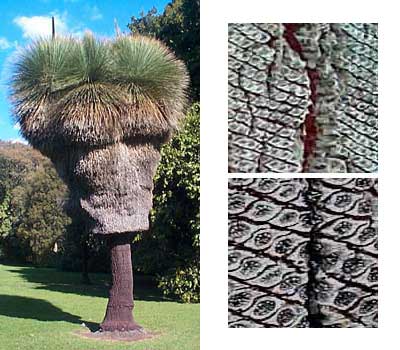
This tree is highly unlikely to have evolved from anything on Earth, simply because it is not related to anything else that we can find here.
Not only the shape of the tree, but also the bark is highly unusual. It feels like a cork, but resembles a honeycomb structure. What could be the origin of Xanthorrhoea tree?
In Thiaoouba Prophecy book you will find an interesting story about the origin of Xanthorrhoea.